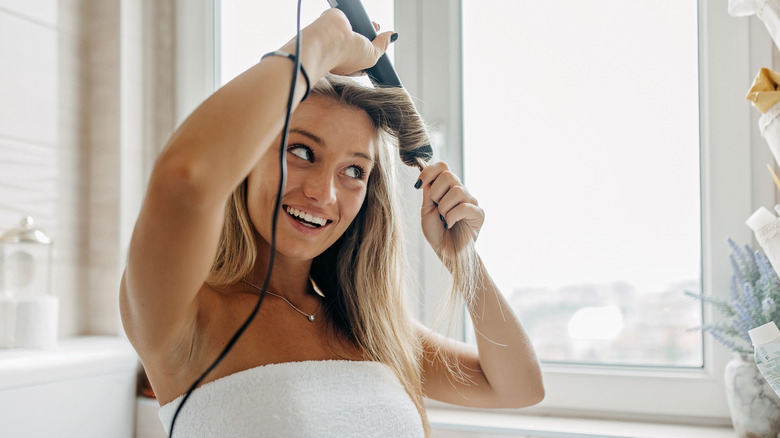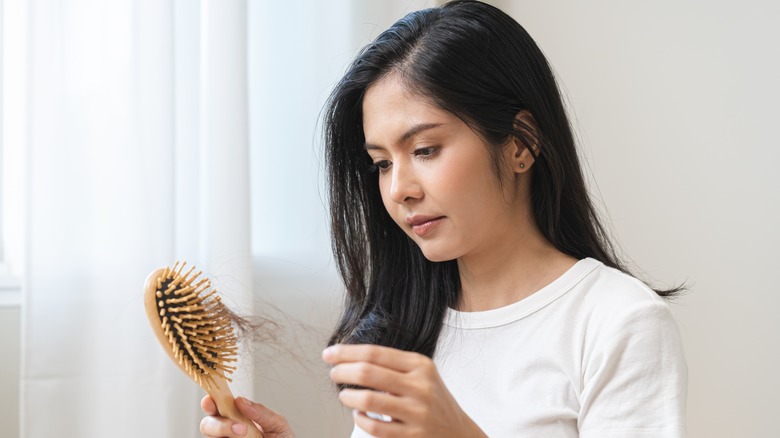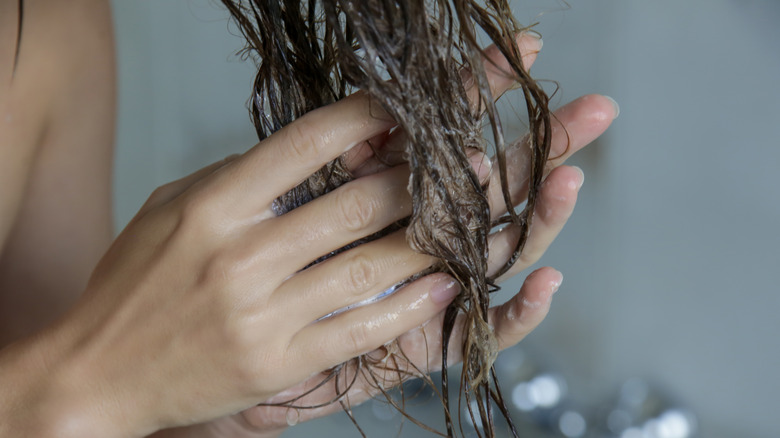How To Hide Your Split Ends Before You Have Time For A Cut, According To Our Hairstylist
Split ends manifest in all kinds of equally unwelcome shapes and forms. No strand is spared when it comes to these troublesome splits, which makes them an unpleasant sight when they grow out of control. And while they're not always a major cause for concern, split ends may alter more than the appearance of your strands; they also affect the texture of your hair, making it rough to the touch. If a significant amount of time has passed since your last haircut, your hair may also appear frizzy.
Thankfully, Lucy Gedjeyan, a celebrity hairstylist and the owner of Lucy Luna Beauty, shared expert advice during an exclusive chat with Glam to help you hide split ends. It's important to note that most people don't actively hone in on the ends of someone's hair. That said, you certainly don't need a reason to want to conceal your split ends. And while you can always skip the salon and cut your split ends at home, these suggestions are for those who prefer to leave their haircuts to the professionals. In the meantime, follow these helpful tips to conceal your split ends in between appointments.
What causes split ends?
Ultimately, split ends are caused by damage to the hair follicles. And, as unfair as it may be, many everyday behaviors or occurrences are responsible for hair damage, such as heat styling, rough treatment, and even the weather, per WebMD. Heat styling tools, such as curling irons, flat irons, and blow dryers, are notorious for causing hair damage due to direct heat exposure to the hair follicles. Many individuals also use high heat levels to speed up the styling process, which increases the risk of damage.
What's more, you may be making your split ends worse by incorrectly handling your strands. Aggressively rubbing your locks with a bath towel to dry your hair, for instance, causes friction and leads to further damage. Brushing hair after a bath also causes damage, as wet hair is especially fragile and prone to breakage (via Healthline).
Finally, extreme weather conditions are also to blame for split ends, as wind or cold air saps the moisture from your hair, leading to dryness. When hair becomes brittle and dry, its strands are effectively damaged, causing split ends in the process.
Split ends vs. breakage
Hair damage is often the root cause of both split ends and breakage, but the damage manifests differently. Split ends only affect the ends of your hair, for instance, while breakage can occur anywhere along the hair shaft. Unlike split ends, general hair breakage may also be a symptom of health issues, including poor diet, hypothyroidism, stress, or eating disorders, per Healthline. Your hair can also exhibit signs of both breakage and split ends in cases of severe hair damage.
Moreover, there are different types of split ends, each brought on by different factors: double splits, partial splits, and tree splits. According to WebMD, the double split is the "most common type of split end" and is characterized by the typical Y-shape. You're more likely to notice double split ends if your hair has been damaged by chemicals or heat.
The partial split is less obvious to the eye, forming a smaller split than a double split. If you notice minor splits at the tips of your strands, some gentle treatment and moisture will prevent the split from growing deeper up the hair shaft. Finally, a tree split occurs when your hair is in desperate need of a trim. As the name suggests, this type of split appears as branch-like splits in the hair shaft instead of a single split down the middle.
If you need help with an eating disorder or know someone who does, help is available. Visit the National Eating Disorders Association website or contact NEDA's Live Helpline at 1-800-931-2237. You can also receive 24/7 Crisis Support via text (send NEDA to 741-741).
How to prevent split ends
The key to preventing split ends is to baby your hair. In other words, treat your hair as gently as you do your skin. You wouldn't neglect your skincare and bombard your face with damaging products or excessive exfoliation, would you? Well, the same idea applies to your precious locks.
Limit the use of harsh chemical products if you're prone to split ends or are struggling to restore your hair to its healthier state. This includes putting a temporary hold on chemical treatments and hair dyes. Similarly, washing your hair too often can strip your strands of their natural oils, resulting in brittle ends, per WebMD. Stretch out your hair wash days as long as you can to give your scalp a chance to produce enough oil to nourish your hair's cuticles.
After washing your hair, it's also a good idea to swap your standard bath towels for a microfiber hair wrap or cotton T-shirt. A microfiber towel will reduce the friction against your hair shafts, which can damage your strands. In our exclusive chat, Lucy Gedjeyan also recommended using silk pillowcases to "help reduce friction and keep hair looking smoother[.]" Then, if you regularly style your hair with heat tools, then using a heat protectant spray or cream is arguably essential for keeping split ends at bay. Distribute the product throughout your hair to protect the tips from heat exposure. "And if you must use heat, try and use a lower temperature," Gedjeyan told Glam.
Apply hydrating hair products
"One of the easiest things you can do to conceal split ends in between salon visits is [to] use a hair mask at home," Lucy Gedjeyan revealed to Glam in our exclusive chat. "This helps restore moisture and strengthen your hair shaft."
Look for nourishing or reparative hair masks to deep condition your thirsty locks. To apply a hair mask, gently wring out your hair to remove excess water, as you want to use the product on damp hair — not sopping wet hair — to allow the ingredients to better penetrate the cuticle (via Healthline). Focus on the ends when using conditioners and masks, but avoid applying shampoo directly to the ends. Instead, apply shampoo to your roots and allow the suds to naturally wash the rest of your hair while rinsing it out. It's also a great idea to make use of leave-in conditioners and hair oils, as they will "hydrate and smooth your ends, giving it a much healthier appearance and feel," according to Gedjeyan.
Then, when it comes to hair color, you need to "make sure your color touch-ups at home are being done correctly," explained Gedjeyan. More specifically, you should "avoid color on your ends, as this can dry them out even more." Instead, relegate the hair color to your roots and "make sure to deep condition right after."
Get creative with your hairstyles
"Another way to conceal split ends is to throw your hair [...] in a quick DIY updo," Lucy Gedjeyan exclusively told Glam. Not only is wrapping your hair in a quick updo a genius tip for tucking in those split ends, but updos also make you appear effortlessly put together. For this trick, opt for an updo or bun that hides your ends, and stay away from messy buns that call for loose stands.
On the other hand, you should avoid tying your hair in severely tight buns or updos, as this will tug at your strands and potentially cause damage. Gedjeyan also warned against styles that require harsh elastic bands. Opt for a satin scrunchie or spiral hair tie to prevent pulling and friction.
For days when you feel like wearing your hair down, make use of scarves or oversized jumpers that will pull attention away from your hair. You can also covertly tuck the ends into your jumper or turtleneck, depending on the length of your hair. When in doubt, however, "[a]dd a claw clip and leave some face-framing pieces down for a little extra pizazz," Gedjeyan recommended.





